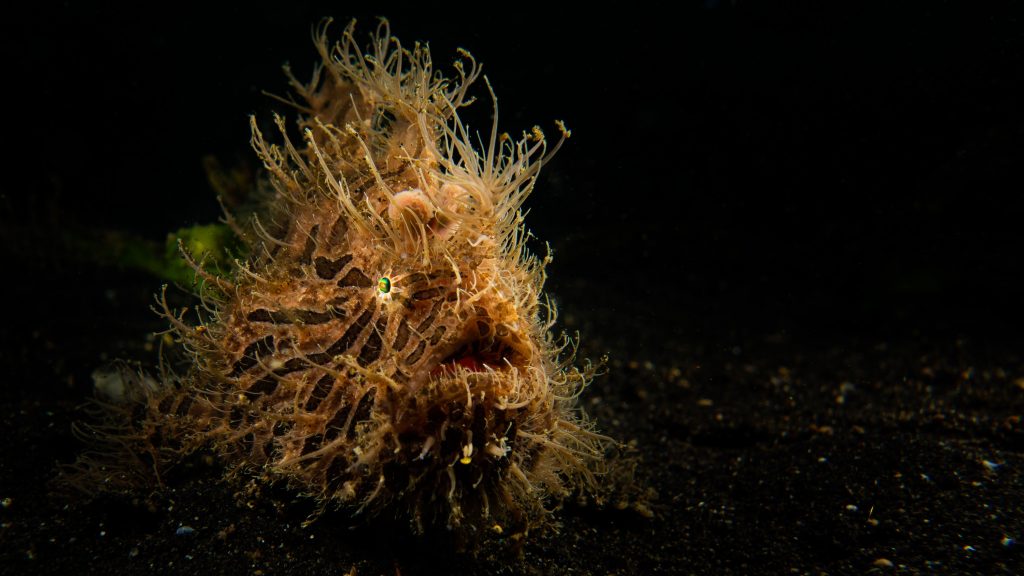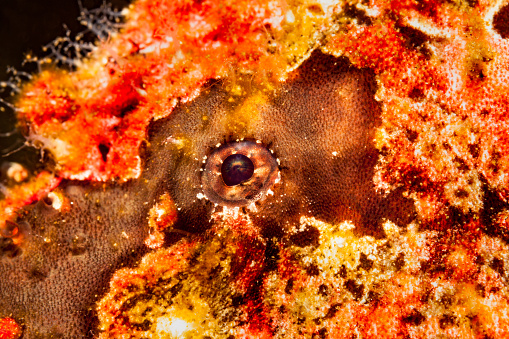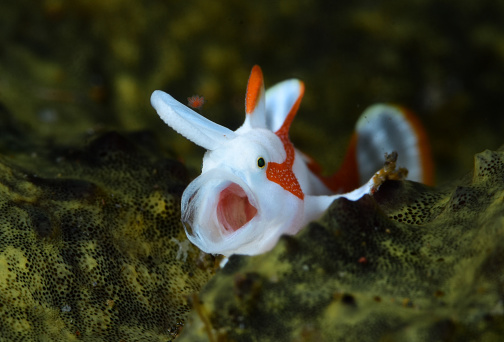A Frogfish is the ocean’s maestro of aggressive imitation, fascinating divers, and terrifying prey. Are frogfish poisonous? Frogfish are one of my favorite aquatic creatures to find. They are rarely notice because they are so highly hides. And it is adaptable to their immediate surroundings. Frogfish are often refers to as disgusting, and the mayor of Bitung, Indonesia, declared them “the spawn of Satan.”
Frogfish Facts
1) A Frogfish is regarded as one of many intricate and efficient instances of assertive mimicry owing to its high concealment and sophisticated luring activities.
2) Frogfish are found in warm and subtropical oceans and number 46 species.
3) Frogfish is a carnivore with the fastest prey engulfment speed of all vertebrates.
4) However, unlike chameleon or any other. The Frogfish cannot change color quickly and must wait several weeks to do so.
5) Frogfishes are divided into two groups. It has a tiny number of giant eggs throughout their development. They are linked to the organ. The other produces many little eggs that float away in the sea currents to protect itself.
6) A frogfish was discovered camouflaging itself against the ghostly corals during a current coral-bleaching episode at Maldives. Where large portions of coral turn pure white.
7) Sexual parasitism occurs in some marine families of a Frogfish, in which little parasitic males adhere to bigger females. Males link with their partners, acquiring nutrients in exchange for sperm.
Additional Frogfish Facts

8) A psychedelic frogfish is only being found on the Indonesian isle of Ambon.
9) A Frogfish uses jet propulsion to swim. Rather than utilizing the tail like other fishes, it propels itself forward using backward-facing tubelike gill openings.
10) Most of the Frogfish’s most ancient cousins are a collection of fourteen handfishes found solely in southern Australia seas. They’re infrequent, and other species have only one known specimen. One of the few fish is the spotted handfish. Only one estuary within southern Tasmania, there is only one estuary that supports this Critically Endangered fish.
11) A Frogfish is born without the swim bladder. Most swimming fishes have this structure, which works similarly to a diver’s BC to keep them buoyant.
12) Frogfish have numerous lures (escae) that they wave next to the mouth to lure prey. Some use shrimp-like interests, while others use fish, worms, or small squids. According to recent research, the striated Frogfish’s appeal is biofluorescent.
13) Hairy Frogfish, also known as striated Frogfish, mainly imitate soft corals or algae, but they may also replicate deadly black urchin.
14) Toxic nudibranchs are imitate by juvenile color Frogfish. They do have something to the concern of their enemies due to this habit, and their prey ignores them, allowing for a simple ambush
Is it possible for a frogfish to be poisonous?
The majority of Frogfish are not toxic, including the hairy Frogfish. There are a few venomous toadfish species in the Batrachoididae family, but they are not Frogfish.
As a result, how does a frogfish appear?
The Frogfish is an expert at concealment. Spots, stripes, warts, skin flaps, and filaments abound on his body. The Frogfish imitates algae-covered rocks or rubble, plants such as Sargassum weed or algae, and creatures such as tunicates, corals, and sponges.
Frogfish, on the other hand, do change color? Frogfishes may change color to fit their surroundings, although, unlike cuttlefish and octopus, this is not a quick process; color changes can take days or even weeks. Frogfish, despite their camouflage, have predators of their own.
Is a frogfish true in this way?
Many species in the sea adopt camouflage. However, the Frogfish is particularly interesting. Frogfish can be find in Africa, Asia, Australia, and North America in tropics and subtropics oceans and seas.
What is the fastest a frogfish can strike?
A frogfish strike can happen in as little as six milliseconds, and they can not only hurl their jaws and mouth outwards, but they can also increase the size of their mouth by up to 12 times, allowing them to seize enormous prey compared to their body size.
Frogfish reproduce in a variety of ways
Fertilization occurs in the water (where males and females release their reproductive cells). Per season, females produce 40.000 to 180.000 eggs. On the ocean floor, eggs are lay in mucus. Some frogfish species do not display parental care for their eggs, whereas others guard them until they hatch.
Is a frogfish consider a fish?
Frogfish are a group of roughly 60 small marine fishes belonging to the Antennariidae family (order Lophiiformes) that live in shallow tropical seas. Frogfishes are lumpy, muscular fish with giant mouths and tough skin.
Is it possible to eat Frogfish?
The majority of Frogfish are not toxic, including the hairy Frogfish. There are a few venomous toadfish species in the Batrachoididae family, but they are not Frogfish. Frogfish have a terrible reputation for taste and should not be consume.
When did the Frogfish first appear?
In 2008, the Frogfish was discover in a coral reef in Indonesia’s Ambon Harbour.
What makes a frogfish a frogfish?
Frogfish, so named because of their squat similarity to common amphibians, varies in size from roughly 5cm to a massive 40cm for the Giant Frogfish. They also have fins that mimic legs, which they use to stroll over the seabed and atop sponges and corals to wait for their food.
How many frogfish species are there?
There are 47 different species.
Is it possible for Frogfish to swim?
Frogfishes may swim in open water using their caudal fin strokes. They also use jet propulsion, which is commonly observe in young Frogfish. It’s done through gulping water in a rhythmic pattern and forcing it out through their gill openings. It is also known as opercular openings, located behind their pectoral fins.
Is it true that Frogfish have legs?
The Frogfish, a member of the antennariid genus, has leg-like fins on both sides of its body and is commonly seen dwelling on the seafloor. “This strange critter is most likely a species of frogfish, but we won’t know for sure until we get a chance to examine it thoroughly!” the New Zealand museum added.
Frogfish hunt in a variety of ways
A frogfish’s camouflage is so good that prey fish will swim right up to it without noticing the predator hiding nearby. The target is then consume in around six milliseconds before he realizes it! The Frogfish is a voracious eater with a mouth cavity that can expand to 12 times its original size, consuming larger meals.
Hairy Frogfish eat what?
Hairy Frogfish aren’t choosy when it comes to food. Crustaceans and other fish, such as flounders, are eaten by them. These guys are known for sneaking up on their victims. Sometimes, though, they lure their prey to them.
Where can you find warty Frogfish?
A maculatus is found throughout the Indo-Pacific region’s tropical waters. From Mauritius and Reunion Island in the middle of the Indian Ocean to the western Pacific Ocean.
Where can you find a hairy frogfish?
Spread. A striated frogfish can widely distributed in tropical areas. From the Indian Ocean to the Pacific Ocean’s center and the Atlantic Ocean along Africa’s western coast. And from New Jersey to the southern Brazilian coast, including the Gulf of Mexico and the Caribbean.
Are Frogfish on the verge of extinction?
It is not extinct.
Facts, identification, and behavior of Frogfish
Frogfish (Frogfish, frogfishes) are misunderstand as poisonous. And little is known about this peculiar underwater predator that lies in wait. Antennarius striatus, or hairy Frogfish, is a unique form of Frogfish that is one of the most famous underwater photography subjects.
Range and Habitats of Frogfish
The Antennaridae family has twelve genera (antennae handling). Frogfish are discover almost everywhere. However, they are sometimes lumped together as kind in different waters. This page focuses on the genus Antennarius, which includes an info-pacific Frogfish.
The equatorial Pacific, Eastern Pacific, Eastern Atlantic, Hawaii (Kona), Indian Ocean, Tropical Australia, Japan, Indonesia, Red Sea, Western Atlantic, and Asia are all home to the Giant Frogfish, Antennarius commersoni. Throughout their lives, Frogfish bear on a variety of colors.
Frogfish Size, Colors, and Life Cycle
Outside of confinement, the entire length of an individual’s lifecycle is unclear. The size could vary between 1/8 inch and 22 inches. A Giant Frogfish can yellow or white as a juvenile, with reddish color patches, and is frequently mistake for the clown frogfish underwater. However, when the person approaches the sex period, the colors might change to black, pink, yellow, green, beige, and other hues, with scab appendages. All Frogfish, however, are said to have chameleon-like abilities. With some actual developing hair appendages.
Predation Behavior of Frogfish
Frogfish, sometimes recognized to be anglerfish, are predators that lurk in the shadows. They’re furnish with an Esca, a specialized interest. This Illicium is a customized fishing stick appendage, while this Esca is a specialty bait. The bait will be dangle at the front of the frogfish’s head using its fishing rod and lure. When an innocent visitor sees the appeal. The predator becomes the prey and becomes excited, paddling towards a simple meal. A carnivore, the Frogfish feeds on little fish.
Frogfish progress incredibly slowly, but they have the highest strike pace of any animal on the planet. They go around gulping water in their enormous mouths. The Frogfish then swims over the bottom or reef by pumping water through its gills. Even as frogfish makes its way thru the surrounding water, huffing, and puffing, its body moves very little.
Is it true that Frogfish are poisonous?
The prevalence of Frogfish are not toxic, including the hairy Frogfishes. There’s a few venomous toadfish species in the Batrachoididae family, but they’re not Frogfish. Frogfish have a terrible reputation for taste and should not consume. Therefore, frogfish are not poisonous but should not consume
Poison threat
As previously stated, the toadfish is a species that is consider dangerous to humans and bathers. Many bathers may run across them and bitten because they are at depths of 10 to 50 meters. His bite is hazardous because of the venom he injects into them.
Although the sting is not fatal, the fact that the bite’s ramifications endure for an extended period is critical. The pain is severe and immediate following the edge. There will be swollenness, hives, and intense burning in the affected area.
The pain may progress all across the limb till it becomes paralyzed, depending on the sort of bite you received. It’s a bacterial infection that causes an inflamed wound to form. It can escalate to more severe issues if not treated properly.
The pain might linger for several days and cause chronic pain in the affected area for several months. Ankylosis has documented in some instances. It’s a sort of sequelae cause by this fish’s bite. And it produces stiffness in the joints around the edge. This inability to move can be partial or complete.
Taking a Walk
Frogfish, unlike most other fish, are born without a swim bladder. This makes it impossible for them to even swim in the water, let alone reach the surface. Instead, the Frogfish moves along the bottom of the water with its fins. They appear to be walking rather than swimming as a result of this. This, together with the Frogfish’s appearance, contributed to the Frogfish’s moniker.
If a frogfish wishes to go quickly, he or she will drink a lot of water using their lips. The water is subsequently squirt out of the Frogfish’s gills. Which are positioned towards the base of the tail. This permits the Frogfish to move faster and cover more ground than they could by walking.
Very adaptable
Frogfish are not poisonous yet should not consume. It have extraordinarily flexible stomach and jawbones to accommodate the food they consume. This implies they can devour prey far larger than their mouths or stomachs. And their bodies will extend to accommodate the meal. Prey twice the size of the Frogfish is still fair game.
Strike Quickly
Frogfish are not poisonous and excellent at taking things slowly and waiting for their dinner. On the other hand, Frogfish rush into action and suck up their victim as soon as food crosses their path. This action is so quick that it holds the world record for the quickest strike. This encompasses all animals, not just other fish or sea life. In just six milliseconds, the Frogfish can suck up its meal. That means that once the Frogfish lunges, it’s nearly impossible to get away.
There are no scales
Scales come to mind when most people think of fish. On the other hand, the Frogfish is not poisonous yet should not be consume. It has no scales while possessing fins and gills. Instead, the Frogfish’s body is cover in bumps. On some types of Frogfish, these bumps can resemble toad warts. The bumps on other Frogfish are more random and dispersed.
The lumps have a critical function. They are a type of camouflage that gives the frogfish texture. This texture can help them blend in with underwater rocks, sponges, and grass. These bumps help the frogfish blend in by ensuring that they aren’t reliant solely on color to conceal themselves.




